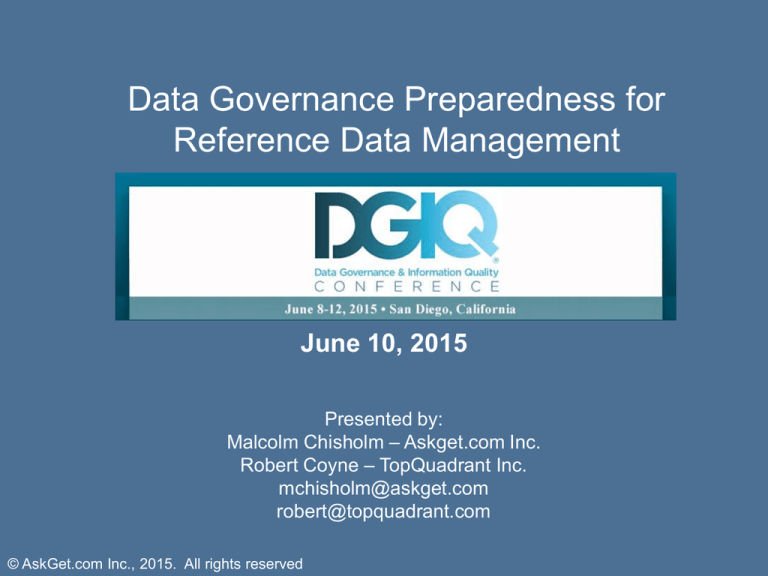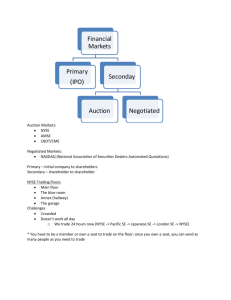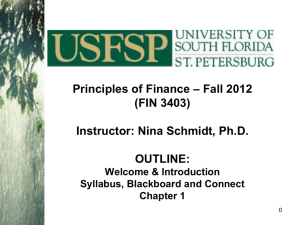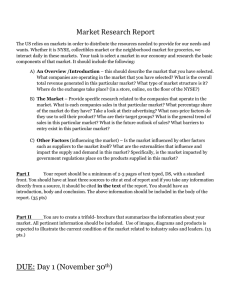
Data Governance Preparedness for
Reference Data Management
June 10, 2015
Presented by:
Malcolm Chisholm – Askget.com Inc.
Robert Coyne – TopQuadrant Inc.
mchisholm@askget.com
robert@topquadrant.com
© AskGet.com Inc., 2015. All rights reserved
Agenda
What is Reference Data?
Semantics and Reference Data
External vs Internal Reference Data
Governing External Reference Data
Reference Data Operating Model
Implementing Reference Data Management
© Askget.com Inc., 2015. All rights reserved
What is Reference Data?
© AskGet.com Inc., 2015. All rights reserved
Reference Data in Context
Increasing:
• Per Value Data Quality Importance
• Semantic Content
Metadata
Reference Data
Transaction Structure Data
Enterprise Structure Data
Transaction Activity Data
Transaction Audit Data
Most Relevant
To Design
Most Relevant
To Outside World
Most Relevant
To Business
Most Relevant
To Technology
Increasing:
• Volume of Data
• Population Later in Time
• Shorter Life Span
© AskGet.com Inc., 2015. All rights reserved
Slide 4
Layers of Data
Metadata
The data that describes all aspects of an enterprise’s information assets,
and enables the enterprise to effectively use and manage these assets.
Here it is confined to the structure of databases. Found in a database’s system catalog.
Sometimes included in database tables.
Reference Data
Any kind of data that is used solely to categorize other data found in a
database, or solely for relating data in a database to information beyond
the boundaries of the enterprise.
Codes and descriptions. Tables containing this data usually have just a few rows and columns.
Transaction
Structure Data
Enterprise
Structure Data
Data that represents the direct participants in a transaction, and which
must be present before a transaction fires.
The parties to the transactions of the enterprise. E.g. Customer, Product.
Data that permits business activity to be reported and/or analyzed by
business responsibility.
Typically, data that describes the structure of the enterprise. E.g. organizational or financial
structure.
Transaction
Activity Data
Data that represents the operations an enterprise carries out
Transaction
Audit Data
Data that tracks the life cycle of individual transactions.
Traditional focus of IT – in many enterprises the only focus.
Includes application logs, database logs, web server logs .
© AskGet.com Inc., 2015. All rights reserved
Layers of Data
Metadata
Metadata
Reference Data
Master Data
Transaction Structure Data
Enterprise Structure Data
Transaction Activity Data
Event Data
Transaction Audit Data
© AskGet.com Inc., 2015. All rights reserved
Specific Data Governance Tasks
Exist for Each Category of Data, E.g.
Semantic meaning of codes
Reference Data
Transaction Structure Data
Enterprise Structure Data
Standards Discovery
Manage Multiple Identities
Historical Hierarchies
These tasks mean many different governance issues exist for MDM
Determine specific management tasks for each category of data
“One size fits all” approaches to data management will not work
© AskGet.com Inc., 2015. All rights reserved
Semantics and Reference Data
© AskGet.com Inc., 2015. All rights reserved
Where Are Semantics?
Customer Type
C
Corporate Customer
I
Individual Customer
G
Government Customer
Data Model
Reference Data Table
Entities (Tables)
Codes
Attributes (Columns)
Business Terms
Relations (Constraints)
Busiess Definitions?
© AskGet.com Inc., 2015. All rights reserved
Need for Definitions in Reference Data
Country
Code
Country
Name
Description
HKG
Hong Kong
The former British crown colony. Now part of the People’s Republic of
China, it is considered a separate territory for our enterprise
PRC
People’s
Republic of
China
Includes Macao and Hong Kong, but excludes Taiwan.
ROC
Republic of
China
Taiwan. Not recognized as an independent country by the People’s
Republic of China, but treated as a separate territory for our enterprise.
Without definitions we really cannot understand Reference Data
© Askget.com Inc., 2015. All rights reserved
Where Are Semantics Stored
Customer Type
Data Model
C
Corporate Customer
I
Individual Customer
G
Government Customer
Reference Data Table
Data Modeler
Business User
Network Drive
Production Database
• Although difficult to estimate it seems that 50% of business semantics (or more)
exist in Reference Data vs Data Models
• The Reference Data tables have Business Terms (“Descriptions”) – the Data
Models have logical “Data Naming Conventions”.
© AskGet.com Inc., 2015. All rights reserved
Lack of Semantics Lead to Coding Errors
What’s the code
for “Hedge
Fund”?
What’s the code
for “Hedge Fund”?
© AskGet.com Inc., 2015. All rights reserved
It doesn’t matter. If
I don’t know the
code I just put in
“999”
Let me look it up–
I’ll search for
“Hedge” *
Got it! OK, I’m all
set – no coding
problem this time
Lack of Semantics Leads to Bad Business Decisions
What goes into “CY
– Cyber Security &
Privacy”?
I’m not sure.
© AskGet.com Inc., 2015. All rights reserved
What goes into
“CY – Cyber
Security &
Privacy”?
It’s a new Lloyds Risk
Code … here’s more
details … it includes both
First and Third Party
External vs Internal Reference Data
© AskGet.com Inc., 2015. All rights reserved
Origin: External Reference Data
External World
Enterprise
• The enterprise has to get at least some Reference Data from outside itself.
• These are “standards” – they allow the enterprise to communicate with other
organizations outside itself (e.g. regulators).
• The enterprise does not have to do the hard work of creating the Reference Data.
• The enterprise does not have to do the hard work of revising the Reference Data.
• This class of Reference Data has its own concerns, and these affect architecture.
© Askget.com Inc., 2013. All rights reserved
Origin: Internal Reference Data
Enterprise
Product Type
Product Line
Order Status
Customer Type
Party Role
Record Type
•
•
•
•
A great deal of Reference Data is managed within the enterprise itself.
It is typically governed poorly.
It is often internally inconsistent.
Much of it is administered by IT
© Askget.com Inc., 2013. All rights reserved
Governing External Reference Data
© AskGet.com Inc., 2015. All rights reserved
Discovery and Conceptual Mapping
External World
Enterprise
Standards Body
Reference Data
Reference Data
Reference Data
Reference Data
RD Stewards
Discovery
Standards Body
Reference Data
Reference Data
Reference Data
Reference Data
• The enterprise must make sense of (a) what it wants to capture as Reference Data; and (b)
what external standards-setting bodies maintain this
• Thus a formal discovery process is required, and a conceptual map (ontology) that must be
kept updated, and a database to capture the results of the discovery efforts
• Discovery will be ongoing.
• All of these translate to important architectural components
© AskGet.com Inc., 2015. All rights reserved
External Source Organization Profiling
External Source
Enterprise
Source
Organization
RD Stewards
Point of Contact
•
•
•
•
Every Source Organization needs a profile.
This will facilitate communications,
This information needs to be stored in some kind of repository and kept up to date
Again, important architectural components
© AskGet.com Inc., 2015. All rights reserved
External Source Reference Data Profiling
External Source
Source Data
•
•
•
•
Enterprise
RD Stewards
Every Source dataset needs profiling
This is to understand the source Reference Data, and where it is to be found
This includes file layouts, semantic analysis - This can be quite complex
Again, important architectural components
© AskGet.com Inc., 2015. All rights reserved
External Reference Data Onboarding
External Source
Enterprise
Target Design
Source Data
Source Target
Mapping
Source Filtering
(Records /
Columns)
RD Stewards
Source
Transformation
Source
Enrichment
First-Time Target
Population
• Onboarding is getting the source Reference Data set into the enterprise for the first time.
• There are many steps, and these reflect the need for distinct data and metadata stores to be
built
• Also the processes may require distinct architectural components
• We now begin to see what solution architectures might look like
• Try to reuse existing architectural components, rather than build new ones
• Note that the complexity extends to governance as well as architecture.
© AskGet.com Inc., 2015. All rights reserved
Subscription Management
External Source
Enterprise
Establish
Subscription
Source Data
Receive
Updates
RD Stewards
Route Updates
for Action
Process /
Follow up
Updates
•
•
•
•
•
Apply Updates
Many external sources offer some kind of subscription.
These need to be established, and the metadata needs to be captured
Infrastructure needs to be set up to receive updates from the subscription
Routing and processing of updates requires additional architectural components
Also, we much check that updates are being processed. Typically, they are received
centrally and distributed to stewards. That way the center can assess if they are being
actioned. This adds to architectural components.
© AskGet.com Inc., 2015. All rights reserved
Periodic Reconciliation
External Source
Enterprise
Compare to
Target Copy
Source Data
Detect
Differences
RD Stewards
Process
Differences
Update Target
• Even with subscriptions, the enterprise copy may drift out of synch with the source
• Periodic reconciliation is needed to detect material differences and provide assurance that
the enterprise’s copy is still in synch with the source.
• The Onboarding Guide, produced during Source Onboarding is vital to understand the
differences that will inevitably be detected
© AskGet.com Inc., 2015. All rights reserved
Reference Data Operating Model
© AskGet.com Inc., 2015. All rights reserved
Central Reference Data Management
Unit
Why Specialized?
Why Centralized?
Reference Data has unique
properties
Need for standardization
E.g. It has meaning, and is added to
production environments
E.g. Which Country Code will be use –
GENC, ISO Alpha-2, ISO Alpha-3…
Reference Data has unique
challenges
Need for one place in enterprise
to deal with external authorities
E.g. It has to be synchronized across many
applications
E.g. Who ensures we get the NAICS
updates
Reference Data has unique
risks
Need to set up governance for
internal reference data mgmt.
E.g. It is often misunderstood leading to
“miscodings” etc.
E.g. How are Customer Type, Product Line
managed?
There are a number of reasons why enterprises should set up a central unit for
RDM
© AskGet.com Inc., 2015. All rights reserved
Slide 25
Governing and Managing Internal Reference Data
Enterprise
Central Reference Data Unit
GOVERNANCE
MANAGEMENT
Internal Reference Data
Producers
Internal Reference Data
Producers
Internal Reference Data
Producers
Internal Reference Data
Producers
Internal Reference Data
Producers
Internal Reference Data
Producers
Reference Data Table
Reference Data Table
Reference Data Table
Reference Data Table
Reference Data Table
Reference Data Table
• Typically Internal Reference Data tables are managed poorly and have no
governance
• Governance is needed to assign accountabilities and enforce standard processes
that drive up quality
© AskGet.com Inc., 2015. All rights reserved
Slide 26
Governing Reference Data in Operational Environments
Enterprise
Internal Reference Data
Producers
Central Reference
Data Unit
Govern
Govern
Reference Data Table
Example:
Customer Type
Why isn’t Corporate
Customer in this table?
Accts Recvbl
OPERATIONS
I think Goldman Sachs
is a Retail Bank…
Order Entry
I’ll use the code for
Asset Manager to book
Private Equity
Sales Data Warehouse
Hmm…no code for
Hedge Fund – I’ll put
one in
Treasury
• Producers of Internal Reference Data may be well governed, but both Internal and External
Reference Data can be misunderstood, misused, and abused in operational environments
• This impacts downstream use, data integrity across the enterprise
• Governance is required
© AskGet.com Inc., 2015. All rights reserved
Slide 27
Summary and Capabilities to Consider in Solutions
•
Profile an External Authority
•
Profile an External Reference Dataset
•
Support Semantic Analysis of each Element in Reference Dataset
•
Document Semantic Analysis
•
Import Reference Data into a Repository
•
Assign Accountabilities for RDM Tasks
•
Track Changes to Reference Data
•
Support Distribution of Reference Data
• There are other capabilities to consider in Reference Data solutions, but these are
fundamental.
© AskGet.com Inc., 2015. All rights reserved
Slide 28
Implementing Reference Data
Management
© AskGet.com Inc., 2015. All rights reserved
Summary and Capabilities to Consider in Solutions
•
Profile an External Authority
•
Profile an External Reference Dataset
•
Support Semantic Analysis of each Element in Reference Dataset
•
Document Semantic Analysis
•
Import Reference Data into a Repository
•
Assign Accountabilities for RDM Tasks
•
Track Changes to Reference Data
•
Support Distribution of Reference Data
• There are other capabilities to consider in Reference Data solutions, but these are
fundamental.
© AskGet.com Inc., 2015. All rights reserved
Overview of TopQuadrant
Focus:
• TopQuadrant was founded in 2001
• Our focus is to harness emerging technology to build practical but
innovative business applications.
Foundation:
We continue our strong commitment to standards-based
approaches to data semantics
Our Mission:
Empower people
—by making enterprise information meaningful
www.topquadrant.com
An RDM Solution Should Emphasize
Flexibility and Extensibility
Provide rich information structures that enable users
to capture anything they need
Enable faster responsiveness to new data
requirements by allowing extension of models
Capture data quality rules -- by those who do the
governance
Make it easy to create exports of tailored views of
reference datasets as web services
© Copyright 2015 TopQuadrant Inc
Slide 32
Summary and Capabilities to Consider in Solutions
•
Profile an External Authority
•
Profile an External Reference Dataset
•
Support Semantic Analysis of each Element in Reference Dataset
•
Document Semantic Analysis
•
Import Reference Data into a Repository
•
Assign Accountabilities for RDM Tasks
•
Track Changes to Reference Data
•
Support Distribution of Reference Data
• There are other capabilities to consider in Reference Data solutions, but these are
fundamental.
© AskGet.com Inc., 2015. All rights reserved
Slide 33
copyright TopQuadrant, Inc. 2015
34
Information About Reference Data:
An Illustration –Market Identifier Codes
• Support Semantic Analysis of each Element in Reference Dataset
• Document Semantic Analysis
© Copyright 2015 TopQuadrant Inc
Slide 35
Information About Reference Data:
An Illustration –Market Identifier Codes-2
• Profile an External Authority
• Profile an External Reference Dataset
Meaningful Metadata Guides the Proper Use and
Governance of Reference Data
© Copyright 2015 TopQuadrant Inc
Slide 36
RACI support
• Assign Accountabilities for RDM Tasks
© Copyright 2015 TopQuadrant Inc
Slide 37
Data in Reference Datasets
Each Reference Dataset Requires Specific
Information in the Dataset
– More is needed than just a code and a description
For each dataset you need to be able to define
what data is in the set
Take for example three different reference datasets
– Market Identifier Codes
– Country Codes
– Currency Codes
copyright TopQuadrant, Inc. 2015
38
Data in Reference Datasets-2
Market Identifier Codes
Market Identifier name-institution
Code
description
acronym
operating creation
MIC
date
AATS
ASSENT ATS
ALDP
AMXO
NYSE ALTERNEXT DARK AMEXDARK XNYS
NYSE AMEX OPTIONS NYSE
XNYS
AQUA
ARCD
AQUA EQUITIES L.P.
ARCA DARK
Country
Codes
AATS
comment
city
ASSENT ATS IS A US EQUITY DARK POOL
OPERATED BY ASSENT, LLC - A SUBSIDIARY
OF SUNGARD.
JERSEY CITY
1-Oct-11 WWW.SUNGARD.COM
WWW.EURONEXT.COM/L
ANDING/EQUITIESOPDARK POOL.
1-May-11 21363-EN.HTML
1-Nov-08 WWW.NYSE.COM
WWW.AQUAEQUITIES.CO REGISTERED MARKET FOR BLOCK
1-Sep-08 M
EQUITIES
DARK POOL.
1-May-11 WWW.NYSE.COM
AQUA
ARCADARK XNYS
iso 3166 2-alpha
ISO Country
country code
Trinidad and Tobago
TT
Tunisia
TN
Turkey
TR
Turkmenistan
TM
Turks and Caicos Islands TC
Currency code
website
Countries using this currency
AED
United Arab
Emirates dirham
United Arab Emirates
784
United Arab Emirates
(the)
AFN
Afghan afghani
Afghanistan
971
Afghanistan
ALL
Albanian lek
Albania
008
Albania
AMD
Armenian dram
Netherlands
Antillean guilder
Armenia
Curaçao (CW), Sint Maarten
(SX)
051
Armenia
Curacao, Sint
Maarten (Dutch Part)
Angolan kwanza
Angola
973
Angola
032
Argentina
Argentina
AOA
ARS
Argentine peso
Numeric code
532
copyright TopQuadrant, Inc. 2015
Argentina
NEW YORK
NEW YORK
iso 3166 3-alpha numeric
former
country code
code
ISO 3166 status
independent country
TTO
780 Officially assigned
TRUE
TUN
788 Officially assigned
TRUE
TUR
792 Officially assigned
TRUE
TKM
795 Officially assigned
TRUE
USSR
TCA
796 Officially assigned
FALSE
Currency name
ANG
NEW YORK
NEW YORK
Issuing country
Currency Codes
Maintaining Reference Data Quality
Reference data quality – correctness, consistency,
accuracy – is important
Different code sets require different sets of rules
For example:
Adding and changing rules needs to be an end user
capability
copyright TopQuadrant, Inc. 2015
40
Accessing Reference Datasets and
Subsets for Use by Different Systems
I. Market Identifier Codes (for US only)
name-institution
Market Identifier Code description
AATS
ASSENT ATS
acronym
ALDP
AMXO
NYSE ALTERNEXT DARK AMEXDARK
NYSE AMEX OPTIONS NYSE
AQUA
ARCD
ARCO
ARCX
AQUA EQUITIES L.P.
ARCA DARK
NYSE ARCA OPTIONS
NYSE ARCA
ARCADARK
NYSE
operating MIC website
city
AATS
WWW.SUNGARD.COM JERSEY CITY
WWW.EURONEXT.CO
M/LANDING/EQUITIES
XNYS
OP-21363-EN.HTML NEW YORK
XNYS
WWW.NYSE.COM
NEW YORK
WWW.AQUAEQUITIES
AQUA
.COM
NEW YORK
XNYS
WWW.NYSE.COM
NEW YORK
XNYS
WWW.NYSE.COM
NEW YORK
XNYS
WWW.NYSE.COM
NEW YORK
• Support Distribution of Reference Data
II. Market Identifier Codes (worldwide)
name-institution
Market Identifier Code description
operating MIC website
MIC Country city
360T
WWW.360T.COM
Germany
ACEX
WWW.ACEINDIA.COM India
MUMBAI
AFET
360T
ACE DERIVATIVES &
COMMODITY
EXCHANGE LTD
AGRICULTURAL
FUTURES EXCHANGE OF
THAILAND
AFET
WWW.AFET.OR.TH
Thailand
BANGKOK
AIXE
AIXECUTE
AIXE
WWW.BEKB.CH
Switzerland
BERNE
ALTX
ALTERNATIVE
EXCHANGE
360T
ACEX
acronym
copyright TopQuadrant, Inc. 2015 WWW.JSE.CO.ZA/MAR
ALTX
XJSE
KETS/ALTX.ASPX
South Africa
FRANKFURT
JOHANNESBUR
41
G
Implementation Checklist
• Manage information about reference datasets as well as the
reference data
• Document the meaning (semantics) of reference data
• Include extensible models for reference data and metadata
• Make it easy to create exports of tailored views of reference
datasets as web services
• Semantically integrate management of business concepts
(models) reference data and metadata
Put the power directly in the hands of Data Stewards,
Application Architects and other stakeholders who govern
and use reference data
© Copyright 2015 TopQuadrant Inc
Slide 42
What do Comprehensive RDM
Solutions Require?
• Much more than a tool – no matter how good,
flexible and extensible it is
• A Central Reference Data Management Unit and
Reference Data Operating Model are needed
– “Governance is needed to assign accountabilities and
enforce standard processes that drive up quality”
• Integrated process, methodology, collaboration,
and organizational change are essential …
• together with the right technology that puts the
right capabilities in the hands of those who
govern and use reference data
copyright TopQuadrant, Inc. 2015
43
topquadrant.com/rdm
A flexible web-based
solution for governing and
provisioning reference data
in the enterprise:
– Governance
– Provisioning
– Comprehensive metadata
– Enrichment
• Recent Whitepaper by Malcolm:
“The Foundations of Successful
Reference Data Management”
• robert@topquadrant.com
copyright TopQuadrant, Inc. 2015
44
Questions and Answers
Data Governance Preparedness for
Reference Data Management
June 10, 2015
Presented by:
Malcolm Chisholm – Askget.com Inc.
Robert Coyne – TopQuadrant Inc.
mchisholm@askget.com
robert@topquadrant.com
© AskGet.com Inc., 2015. All rights reserved








